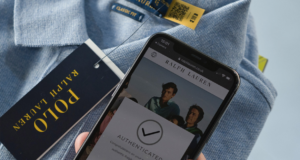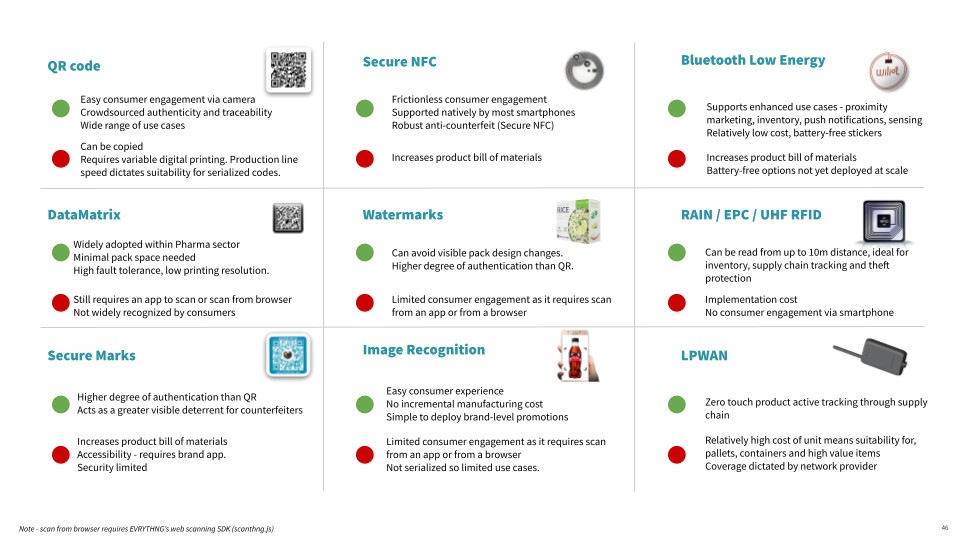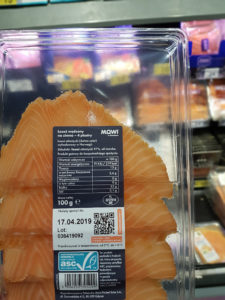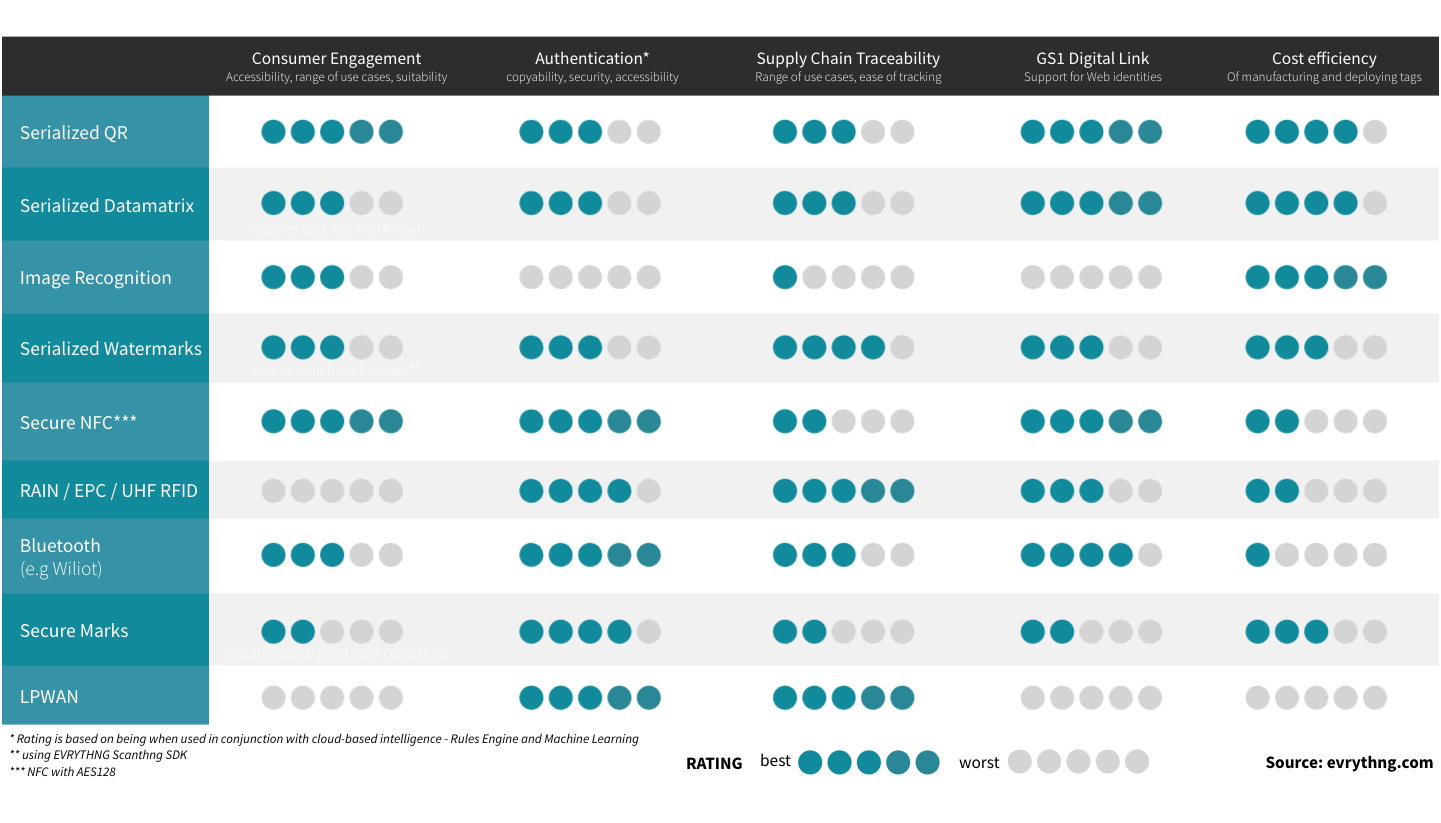Today, consumers expect end-to-end traceability, authenticity and engaging experiences from consumer product brands — from packaged goods to apparel items to pharmaceuticals. How do consumer brands deliver on these expectations? Not only deliver on expectations, but manage them throughout a product’s lifecycle?
Over the past year product digitisation has become the norm rather than the exception. Increasingly brands are turning to digital identities to track and trace products through the supply chain. Where it gets complicated — and what you will learn in this blog — is in the number of different tagging options brands now have when digitising products. Choosing the right one can be overwhelming.
Let me guide you through the range of tagging technologies and their applications so you can make the right choice for your business and your customers.
Did you know that the Internet of Things was coined to describe a world in which every single product in the world is connected to the Web with a tagging technology like RFID? With more than 4 trillion consumer products being made, shipped and sold across the globe each year, the need for digitisation and end-to-end supply chain traceability continues to grow in importance. The recent pandemic has only heightened this need. The ability to track and trace a product through its entire lifecycle is no longer just a supply chain issue for consumer brands, but a business requirement.
Why Digitisation?
Brands need end-to-end visibility and transparency across sourcing, production and distribution to run operations with agility, resilience, and control. The digitisation of product items provides for the collection and integration of granular data across each stage of the supply chain. Data for example can be organised in a Product Cloud for application with real-time analytics and intelligence. The result is more responsiveness to changes in sales channels and customer needs, shorter turn-arounds between design and delivery, optimised transportation, and routing production to where materials may be.
The key to achieving end-to-end visibility and transparency is the ability to interoperate with myriad partners and technologies across the supply chain. At a strategic level, this means choosing the right digitisation and tagging technologies to allow collaboration throughout a product’s lifecycle journey.
Historically, the aggregation and sharing of data hasn’t been quick, easy, or cost-effective — especially at scale. By turning each product item into a data generating asset with a digital identity, brands can disrupt the status quo and lead with business strategies influenced by real-time data intelligence.
Now that we’ve clarified the need for product digitisation, let’s jump to the more complex discussions of: 1. the format of these product identities and 2. the types of tags that should hold them.
Choosing the Right Format for Digital Product Identities
While the world’s original tag, the good old one-dimensional (GS1) barcode did the job for more than 45 years, its relevance is changing in a mobile-first global economy. With eCommerce growing at an unprecedented rate, digitised products provide a mechanism for brand owners to scale dynamic direct-to-consumer engagements across a complex set of product lines, brands, markets, and channels. One of many critical enablers in this dynamic could be GS1 Digital Link which upgrades the ubiquitous one-dimensional barcode so that every product item can now be smartphone-interactive, transact with point-of-sale systems and connect on the web — all with one digitised code on the product.
Essentially, more and more new standards provide a (structured) web address for each and every product. The difference being that a URL or Uniform Resource Locator inclusive solutions are fully integrated with the Web.
As an example, the following URL is a compliant GS1 Digital Link: https://dfnnr.tn.gg/01/860080001300/21/445
The example above contains both a GTIN (Global Trade Item Number – 860080001300) licensed and commercialised through GS1 and a serial number (445).
Many URL based approaches can allow consumer brands to now literally create products “born digital” with any web compatible digital product identity at the time of manufacture. Digitising products at scale brings immediate transparency to both brands and consumers — helping achieve sustainable circularity goals while combating parallel trade, counterfeiting and other brand integrity threats.
Choosing the Right Type of Tag to Host a Digital Identity
Which physical tag, sometimes referred to as a data carrier, is best for your brand to use to carry its digital product identities? As hinted before, there isn’t a one-size-fits-all answer to this question. All tags have pros and cons.
As a rule, we believe that the future of product identities should be tag agnostic. This is an important criterion when choosing your digital identity or cloud provider. In other words, you do not want the destiny of your product digital identities to be locked in one particular type of tag.
There are many types of tags, ranging from QR and Data Matrix codes to digital watermarks to Near Field Communication – NFC tags to RAIN RFID tags to Bluetooth Low Energy labels, and even LPWAN – Low Power Wide Area Network Tags. On top of partnering with a tag agnostic product identity provider, I recommend selecting a standards-based tag that supports Web URLs. Why is this criterion important? Today’s consumer expects personalised experiences and transparency into the products they purchase, wear, and consume.
On top of partnering with a tag agnostic product identity provider, there is a simple technical detail to help ensure that your tag strategy endures: ideally it should directly support URLs or, at the very least, support a simple way to convert to a URL. This is especially important when considering potential consumer experiences.
Future-Proofed
If you are reading this blog because you want a clear and educated answer to how to select the best tagging technology, I’ll summarise with my top picks.
If I had to choose one future proof product identity format it would be:
- Web-enabled creating a true bridge between the physical world and the Internet.
- Based on an open standard and brands don’t get locked into a single technology provider.
If I had to choose a single tag to store a digital identity today, it would be a serialised QR code. Serialised QR codes are:
- Accessible and universally recognised by consumers worldwide (COVID clearly helped with raising awareness of QR codes),
- Supported by all smartphones and supply chain readers, and
- Relatively simple to deploy at scale.
All in all, connected packaging is evolving at an unprecedented rate and in the process, disrupting the way brands and consumers interact. All factors considered, there will probably never be ‘one tag to rule them all’ and flexibility will always be key. The future of consumer brands in the digital world will require a tag agnostic strategy with convergence happening at the product identity layer.




